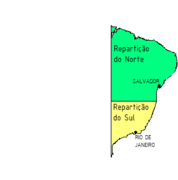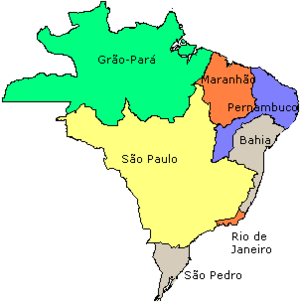| Flag |
State |
Abbreviation |
Capital |
Area (km²) |
Area (sq mi) |
Population (2014) |
Density (2014) (km²) |
Density (2014) (sq mi) |
GDP (% total) (2012) |
GDP per capita (R$) (2012) |
HDI (2010) |
Literacy (2014) |
Infant mortality (2014) |
Life expectancy (2014) |
|---|
 |
Acre |
AC |
Rio Branco |
7005152581400000000♠152,581.4 |
7004589120000000000♠58,912 |
7005790101000000000♠790,101 |
7000447000000000000♠4.47 |
7001130000000000000♠13 |
7000962900000000000♠9.629 (6999200000000000000♠0.2%) |
7001126900000000000♠12.690 |
6999663000000000000♠0.663 |
94% |
7001160000000000000♠16‰ |
7001754000000000000♠75.4 |
 |
Alagoas |
AL |
Maceió |
7004277677000000000♠27,767.7 |
7004107210000000000♠10,721 |
7006332173000000000♠3,321,730 |
7002112300000000000♠112.3 |
7002309000000000000♠309 |
7001295450000000000♠29.545 (6999700000000000000♠0.7%) |
7000933300000000000♠9.333 |
6999631000000000000♠0.631 |
90% |
7001170000000000000♠17‰ |
7001735000000000000♠73.5 |
 |
Amapá |
AP |
Macapá |
7005142814600000000♠142,814.6 |
7004551510000000000♠55,151 |
7005750912000000000♠750,912 |
7000469000000000000♠4.69 |
7001130000000000000♠13 |
7001104200000000000♠10.420 (6999200000000000000♠0.2%) |
7001149140000000000♠14.914 |
6999708000000000000♠0.708 |
99% |
7001160000000000000♠16‰ |
7001754000000000000♠75.4 |
 |
Amazonas |
AM |
Manaus |
7006157074570000000♠1,570,745.7 |
7005606470000000000♠606,470 |
7006387374300000000♠3,873,743 |
7000223000000000000♠2.23 |
7000600000000000000♠6 |
7001641200000000000♠64.120 (7000170000000000000♠1.7%) |
7001178550000000000♠17.855 |
6999674000000000000♠0.674 |
96% |
7001190000000000000♠19‰ |
7001737000000000000♠73.7 |
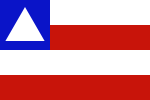 |
Bahia |
BA |
Salvador |
7005564692700000000♠564,692.7 |
7005218030000000000♠218,030 |
7007151263710000000♠15,126,371 |
7001248200000000000♠24.82 |
7001690000000000000♠69 |
7002167727000000000♠167.727 (7000380000000000000♠3.8%) |
7001118320000000000♠11.832 |
6999660000000000000♠0.660 |
91% |
7001200000000000000♠20‰ |
7001743000000000000♠74.3 |
 |
Ceará |
CE |
Fortaleza |
7005148825600000000♠148,825.6 |
7004574620000000000♠57,462 |
7006884279100000000♠8,842,791 |
7001568000000000000♠56.8 |
7002153000000000000♠153 |
7001901320000000000♠90.132 (7000200000000000000♠2.0%) |
7001104730000000000♠10.473 |
6999682000000000000♠0.682 |
93% |
7001165000000000000♠16.5‰ |
7001749000000000000♠74.9 |
.svg.png) |
Distrito Federal |
DF |
Brasília |
7003582210000000000♠5,822.1 |
7003224990000000000♠2,249.9 |
7006285237200000000♠2,852,372 |
7002444660000000000♠444.66 |
7003126800000000000♠1,268 |
7002171236000000000♠171.236 (7000390000000000000♠3.9%) |
7001646530000000000♠64.653 |
6999824000000000000♠0.824 |
98.8% |
7000650000000000000♠6.5‰ |
7001798000000000000♠79.8 |
 |
Espírito Santo |
ES |
Vitória |
7004460775000000000♠46,077.5 |
7004177910000000000♠17,791 |
7006388504900000000♠3,885,049 |
7001762500000000000♠76.25 |
7002218000000000000♠218 |
7002107328999900000♠107.329 (7000220000000000000♠2.2%) |
7001299960000000000♠29.996 |
6999740000000000000♠0.740 |
99% |
7000480000000000000♠4.8‰ |
7001801009999900000♠80.1 |
 |
Goiás |
GO |
Goiânia |
7005340086700000000♠340,086.7 |
7005131310000000000♠131,310 |
7006652322200000000♠6,523,222 |
7001176509999900000♠17.65 |
7001490000000000000♠49 |
7002123926000000000♠123.926 (7000240000000000000♠2.4%) |
7001201340000000000♠20.134 |
6999735000000000000♠0.735 |
97% |
7000900000000000000♠9‰ |
7001759000000000000♠75.9 |
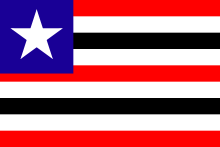 |
Maranhão |
MA |
São Luís |
7005331983300000000♠331,983.3 |
7005128180000000000♠128,180 |
7006685088400000000♠6,850,884 |
7001198109999900000♠19.81 |
7001530000000000000♠53 |
7001589200000000000♠58.920 (7000120000000000000♠1.2%) |
7000876000000000000♠8.760 |
6999639000000000000♠0.639 |
90% |
7001190000000000000♠19‰ |
7001725000000000000♠72.5 |
 |
Mato Grosso |
MT |
Cuiabá |
7005903357900000000♠903,357.9 |
7005348790000000000♠348,790 |
7006322435700000000♠3,224,357 |
7000336000000000000♠3.36 |
7000900000000000000♠9 |
7001808300000000000♠80.830 (7000150000000000000♠1.5%) |
7001259450000000000♠25.945 |
6999725000000000000♠0.725 |
94% |
7001130000000000000♠13‰ |
7001746009999900000♠74.6 |
 |
Mato Grosso do Sul |
MS |
Campo Grande |
7005357125000000000♠357,125.0 |
7005137890000000000♠137,890 |
7006261965700000000♠2,619,657 |
7000686000000000000♠6.86 |
7001190000000000000♠19 |
7001544710000099999♠54.471 (7000100000000000000♠1.0%) |
7001217440000000000♠21.744 |
6999729000000000000♠0.729 |
97% |
7000700000000000000♠7‰ |
7001761009999900000♠76.1 |
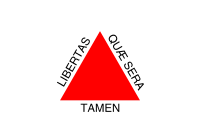 |
Minas Gerais |
MG |
Belo Horizonte |
7005586528300000000♠586,528.3 |
7005226460000000000♠226,460 |
7007207340970000000♠20,734,097 |
7001334109999999999♠33.41 |
7001910000000000000♠91 |
7002403551000000000♠403.551 (7000920000000099999♠9.2%) |
7001203240000000000♠20.324 |
6999731000000000000♠0.731 |
98.6% |
7000610000000000000♠6.1‰ |
7001787000000000000♠78.7 |
 |
Pará |
PA |
Belém |
7006124768950000000♠1,247,689.5 |
7005481740000000000♠481,740 |
7006807392400000000♠8,073,924 |
7000607000000000000♠6.07 |
7001160000000000000♠16 |
7001910090000000000♠91.009 (7000190000000000000♠1.9%) |
7001116780000000000♠11.678 |
6999646000000000000♠0.646 |
94% |
7001160000000000000♠16‰ |
7001742000000000000♠74.2 |
 |
Paraíba |
PB |
João Pessoa |
7004564398000000000♠56,439.8 |
7004217920000000000♠21,792 |
7006394388500000000♠3,943,885 |
7001667000000000000♠66.70 |
7002180000000000000♠180 |
7001387310000000000♠38.731 (6999800000000000000♠0.8%) |
7001101510000000000♠10.151 |
6999658000000000000♠0.658 |
92% |
7001170000000000000♠17‰ |
7001741009999900000♠74.1 |
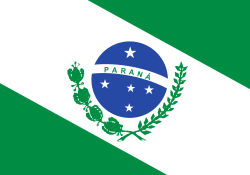 |
Paraná |
PR |
Curitiba |
7005199314900000000♠199,314.9 |
7004769560000000000♠76,956 |
7007110816920000000♠11,081,692 |
7001524000000000000♠52.40 |
7002143000000000000♠143 |
7002255927000000000♠255.927 (7000580000000000000♠5.8%) |
7001241940000000000♠24.194 |
6999749000000000000♠0.749 |
98% |
7000700000000000000♠7‰ |
7001778000000000000♠77.8 |
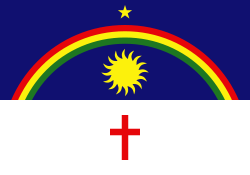 |
Pernambuco |
PE |
Recife |
7004983116000000000♠98,311.6 |
7004379580000000000♠37,958 |
7006927772700000000♠9,277,727 |
7001896200000000000♠89.62 |
7002244000000000000♠244 |
7002117340000000000♠117.340 (7000230000000099999♠2.3%) |
7001131380000000000♠13.138 |
6999673000000000000♠0.673 |
92% |
7001190000000000000♠19‰ |
7001748000000000000♠74.8 |
 |
Piauí |
PI |
Teresina |
7005251529200000000♠251,529.2 |
7004977260000000000♠97,726 |
7006319417800000000♠3,194,178 |
7001124000000000000♠12.4 |
7001320000000000000♠32 |
7001257210000000000♠25.721 (6999500000000000000♠0.5%) |
7000813700000000000♠8.137 |
6999646000000000000♠0.646 |
90% |
7001180000000000000♠18‰ |
7001727000000000000♠72.7 |
 |
Rio de Janeiro |
RJ |
Rio de Janeiro |
7004436961000000000♠43,696.1 |
7004168710000000000♠16,871 |
7007164611730000000♠16,461,173 |
7002365230000000000♠365.23 |
7002975000000000000♠975 |
7002504221000000000♠504.221 (7001115000000000000♠11.5%) |
7001310640000000000♠31.064 |
6999761000000000000♠0.761 |
99% |
7001130000000000000♠13‰ |
7001771009999900000♠77.1 |
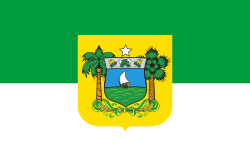 |
Rio Grande do Norte |
RN |
Natal |
7004527968000000000♠52,796.8 |
7004203850000000000♠20,385 |
7006340851000000000♠3,408,510 |
7001599900000000000♠59.99 |
7002167000000000000♠167 |
7001395449999900000♠39.544 (6999900000000000000♠0.9%) |
7001122490000000000♠12.249 |
6999684000000000000♠0.684 |
95.1% |
7001138000000000000♠13.8‰ |
7001767000000000000♠76.7 |
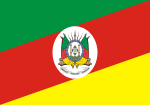 |
Rio Grande do Sul |
RS |
Porto Alegre |
7005281748500000000♠281,748.5 |
7005108780000000000♠108,780 |
7007112072740000000♠11,207,274 |
7001379600000000000♠37.96 |
7002103000000000000♠103 |
7002277658000000000♠277.658 (7000630000000000000♠6.3%) |
7001257790000000000♠25.779 |
6999746000000000000♠0.746 |
99% |
7000400000000000000♠4‰ |
7001793000000000000♠79.3 |
 |
Rondônia |
RO |
Porto Velho |
7005237576200000000♠237,576.2 |
7004917290000000000♠91,729 |
7006174853100000000♠1,748,531 |
7000658000000000000♠6.58 |
7001190000000000000♠19 |
7001293620000000000♠29.362 (6999600000000000000♠0.6%) |
7001130750000000000♠13.075 |
6999690009999900000♠0.690 |
94.6% |
7001185000000000000♠18.5‰ |
7001737000000000000♠73.7 |
 |
Roraima |
RR |
Boa Vista |
7005224299000000000♠224,299.0 |
7004866020000000000♠86,602 |
7005496936000000000♠496,936 |
7000200999999999999♠2.01 |
7000500000000000000♠5 |
7000731400000000000♠7.314 (6999200000000000000♠0.2%) |
7001155570000000000♠15.557 |
6999707000000000000♠0.707 |
94.5% |
7001151000000000000♠15.1‰ |
7001735000000000000♠73.5 |
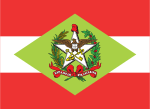 |
Santa Catarina |
SC |
Florianópolis |
7004953462000000000♠95,346.2 |
7004368130000000000♠36,813 |
7006672714800000000♠6,727,148 |
7001652690000000000♠65.27 |
7002182000000000000♠182 |
7002177276000000000♠177.276 (7000400000000000000♠4.0%) |
7001277710000000000♠27.771 |
6999774000000000000♠0.774 |
99% |
7000300000000000000♠3.0‰ |
7001810000000000000♠81 |
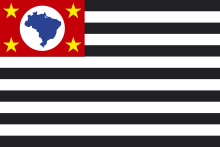 |
São Paulo |
SP |
São Paulo |
7005248209400000000♠248,209.4 |
7004958340000000000♠95,834 |
7007440353040000000♠44,035,304 |
7002166230000000000♠166.23 |
7002459000000000000♠459 |
7003140890400000000♠1,408.904 (7001321000000000000♠32.1%) |
7001336240000000000♠33.624 |
6999783000000000000♠0.783 |
99% |
7000450000000000000♠4.5‰ |
7001798000000000000♠79.8 |
 |
Sergipe |
SE |
Aracaju |
7004219103000000000♠21,910.3 |
7003845960000000000♠8,459.6 |
7006221951400000000♠2,219,514 |
7001943600000000000♠94.36 |
7002262000000000000♠262 |
7001278230000000000♠27.823 (6999600000000000000♠0.6%) |
7001131800000000000♠13.180 |
6999665000000000000♠0.665 |
93% |
7001180000000000000♠18‰ |
7001730000000000000♠73.0 |
 |
Tocantins |
TO |
Palmas |
7005277620900000000♠277,620.9 |
7005107190000000000♠107,190 |
7006149688000000000♠1,496,880 |
7000498000000000000♠4.98 |
7001130000000000000♠13 |
7001195300000000000♠19.530 (6999400000000000000♠0.4%) |
7001137750000000000♠13.775 |
6999699000000000000♠0.699 |
94% |
7001170000000000000♠17‰ |
7001745000000000000♠74.5 |
|
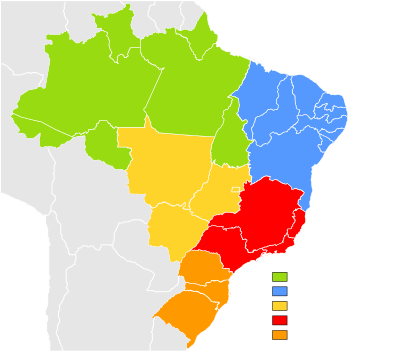

 Wikimedia Atlas of Brazil
Wikimedia Atlas of Brazil
